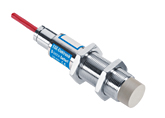Manufacturer: EGE Elektronik
Category: Inductive proximity switches
The inductive proximity switches series IGV are used in areas with heavy-duty mechanical loads at the sensor's face or where seals between face and housing cannot be used. Chips hitting the front or frequently changing coolants or lubricants do not diminish the function of these proximity switches. The varients with a PTFE coating are particularly well-suited for welding lines and similar environments where sensors are exposed to heavy soiling. Metal face switches are manufactured from stainless steel and are one solid piece. They detect iron and steel through the metal front face.
Description
EGE offers special inductive proximity switches for special applications. Focus is on TROPICAL switches which exceed IP 69K with a temperature range up to +120 °C and is optimally suited for corrosive environments. High temperature switches up to 160 °C are also offered. Other hot area sensors can be used in temperatures up to 250 °C. The lower end of the temperature scale is at -60 °C and applies to the POLAR switches. Large switching distances up to 170 mm and sensors resistant to rolling oils made from PTFE, PP or PEEK are also available for the food industry. Intrinsically safe ex-classified sensors according to ATEX and compact dust-EX and gas-EX sensors complete the product program.
The "demanding environment" sensors offered by EGE are specially designed for harsh environments in which sensors are exposed to high electrical, electromagnetic or mechanical stresses. Stresses are not always included in customary inspection and test methods in the way that they develop in different production environments. Therefore, EGE has developed special test methods that are better suited to the use of sensors in critical applications. This has resulted in sensor designs that are suitable for use in almost any environment.


